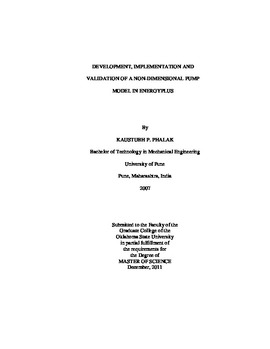| dc.contributor.advisor | Fisher, Daniel | |
| dc.contributor.author | Phalak, Kaustubh P. | |
| dc.date.accessioned | 2014-04-17T19:53:34Z | |
| dc.date.available | 2014-04-17T19:53:34Z | |
| dc.date.issued | 2011-12-01 | |
| dc.identifier.uri | https://hdl.handle.net/11244/10024 | |
| dc.description.abstract | In HVAC plant simulation software, a pump model is required to carry out pressure based simulation, which will govern flow rate in system and predict accurate power consumption. To implement a pump model in EnergyPlus, which will predict pump performance with varied pump parameters such as rotational speed and pump diameter pump performance models and non-dimensional model was studied. Their applicability and accuracy was checked experimentally and with manufacturer's data. Using the pump performance prediction model effect of pump parameters on its performance was observed. Also applicability of affinity laws to predict pump power savings was studied. It was observed that performance prediction models calculate the pump performance with sufficient accuracy but are not suitable to implement in energy simulation programs when the pump has been specified and pump curves are available. These models can be used to determine the effect of each individual parameter on the performance curve. When the size of the pump is unknown, in a hydronic system sizing calculation, these models can be used to predict the inlet and outlet diameters of the pump impeller, assisting the designer in sizing the pump for the system. Due to simplicity, less number of input requirements and accuracy a non-dimensional model was found to be suitable for energy simulation purpose. But, when checked with manufacturer's data it was observed that these non-dimensional models cannot be used directly for variation in impeller diameter. A modified non-dimensional model was suggested which not only satisfied the pump affinity laws but also gave better results as compared to earlier non-dimensional model suggested by Clark (1985). This modified non-dimensional model with VFD control is implemented in EnergyPlus. It was also found that pump affinity laws can be used for predicting power savings only if there is linear relationship between input and output power of the pumping system. The ranges for applicability of the pump affinity laws to predict power savings were found using standard electrical motor efficiency curves. | |
| dc.format | application/pdf | |
| dc.language | en_US | |
| dc.publisher | Oklahoma State University | |
| dc.rights | Copyright is held by the author who has granted the Oklahoma State University Library the non-exclusive right to share this material in its institutional repository. Contact Digital Library Services at lib-dls@okstate.edu or 405-744-9161 for the permission policy on the use, reproduction or distribution of this material. | |
| dc.title | Development, Implementation and Validation of a Non-dimensional Pump Model in Energyplus | |
| dc.type | text | |
| dc.contributor.committeeMember | Spitler, Jeffrey | |
| dc.contributor.committeeMember | Cremaschi, Lorenzo | |
| osu.filename | Phalak_okstate_0664M_11707.pdf | |
| osu.college | Engineering, Architecture, and Technology | |
| osu.accesstype | Open Access | |
| dc.description.department | Mechanical & Aerospace Engineering | |
| dc.type.genre | Thesis | |
| dc.subject.keywords | mechanical engineering | |
